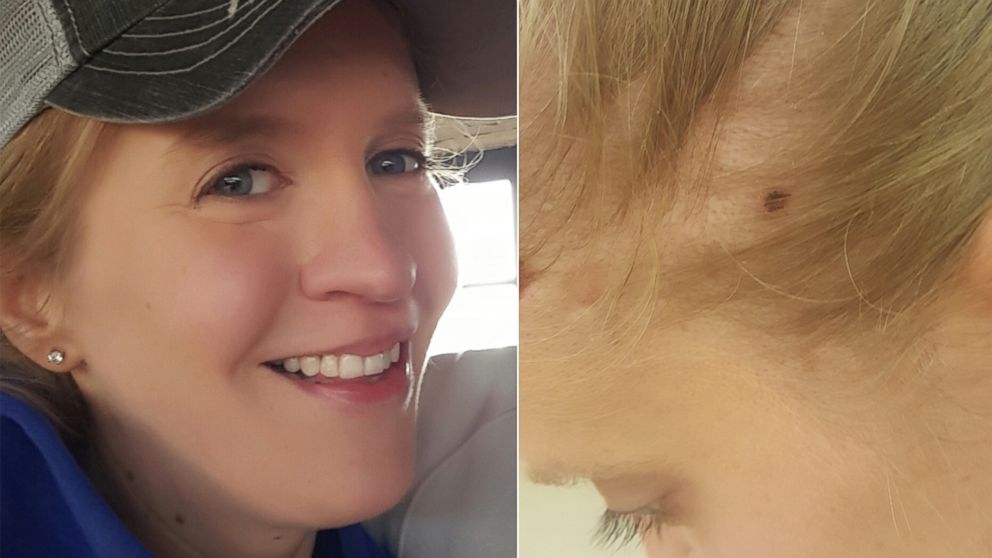How This Personal Trainer Manages Gorlin Syndrome, Which Results in Repeated Skin Cancer
Erica Dingler has had dozens of carcinomas removed.

— -- When Erica Dingler was 12, she noticed a small white spot in her jaw almost like a tooth poking through.
She remembers the physician took one look at her jaw and and asked to see her palms. Dingler's palms had small pits in it -- a class sign of a rare genetic condition called Gorlin syndrome.
The disease affects about 1 in 57,000 people in the U.S. and is due to mutations on a gene called the PTCH1 gene. People who have the genetic mutation are significantly more likely to develop skin cancer, specifically the cancer called basal cell carcinoma. While it is the most common form of skin cancer and it is rarely fatal, but can require surgery to remove cancerous masses. At 12, Dingler faced a lifetime of doctor's appointments and check-ups to look for signs of cancer.
Dingler, now 32, has been through dozens of procedures and surgeries to remove the cancerous masses on her face and scalp, with three removed in the last month. She said she's now been inspired to speak out about the condition so that others can understand what it's like to live with the disease and give hope to newly diagnosed patients that they can live a normal life.
She said in the beginning she felt she could not be a normal kid after her doctors gave stern warnings that she needed to stay out of the sun, a tall order for the adolescent girl who loved the beach.
"At first I was definitely a little nervous because my dermatologist at least gave me the impression that I should almost stay in a hole," Dingler recalled. "For a 12-year-old girl, at the time you're trying to find yourself."
She said initially she felt nervous about simply going outside to be with friends or go to school events, but eventually she learned how to properly protect herself with sunscreen and hats to decrease her chance of developing skin cancer.
"For 20 years now I've been going through many doctor's visits and making sure I watch my skin," Dingler told ABC News. "Sunscreen is my friend right now."
But despite all her efforts, Dingler has not been able to avoid the carcinomas that are so common for Gorlin patients. She estimates she's had anywhere between 20 to 40 basal cell carcinomas, and in the past month has had three cancerous or possibly cancerous growths removed.
"This past week I had to have a big patch on my lip and forehead," she said of after the carcinomas were removed. "It does make you a little bit self-conscious and a little bit self-aware."
Dr. Hooman Khorasani, chief of the Division of Dermatology and Cosmetic Surgery at Mount Sinai Health System in New York, said he estimates that he's taken at least 25 carcinomas or likely-carcinomas from Dingler. Three carcinomas were removed in the last month.
He emphasizes his goal is to make sure he leaves her with as little scarring as possible, while removing any cancerous tissue.
"One of the most important things is for us to make sure she doesn't look deformed," said Khorasani, explaining he takes extra care to minimize potential scars.
It's rare for these kinds of basal cell carcinomas to become fatal, Khorasani said, unless a person doesn't receive treatment or if their immune system is compromised. Gorlin syndrome is also associated with other health effects, including a slightly larger head size, benign jaw tumors that can displace teeth and increased chance of other kinds of tumors, including a brain tumor called medulloblastoma, often detected in childhood.
The toll of these health conditions can also affect the mental health of people with Gorlin syndrome. Multiple studies have found Gorlin patients are at a higher risk of depression and other psychological issues. One published study found that 56 percent of people with Gorlin syndrome reported depression or use of antidepressants. The same percentage reported anxiety about possible future surgical procedures to have carcinomas removed.
Helping patients cope with the disease is key, Khorasani said, and he works with other specialists, including a counselor and psychiatrist, when treating patients. Most Gorlin syndrome patients are diagnosed in their late teens or early 20's, just as they're heading out into the world.
"Being able to counsel patients about these things and making sure their mental health is OK," is important, he said, noting that the condition doesn't have to mean a patient stays hidden away for their whole lives. He pointed to Dingler as an role model.
"She's very functional and [has a] very amazing attitude about it," he said. "She's very good at being upbeat."
Dingler said years of dealing with the disease and learning how to cope have helped give her a positive outlook.
"I can go and live a regular life," she said. "The sun is still my friend."
Recently married with a job as a professional trainer, Dingler said simply living with the condition for so long has toughened her up for questions about her scars or bandages.
"If anything for a New Yorker, it's helped me have a thicker skin both literally and figuratively," she said.
Dr. Meghan Feely contributed to this report. She is a dermatologist at Windsor Dermatology on staff at the University Medical Center at Princeton who serves as a media expert for the American Academy of Dermatology.




